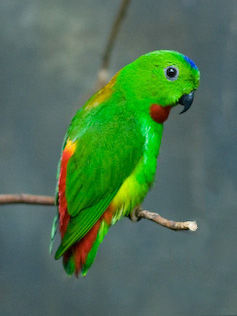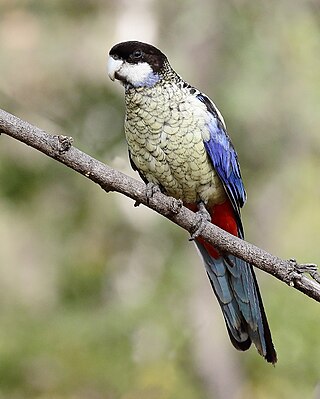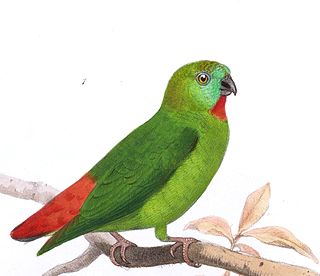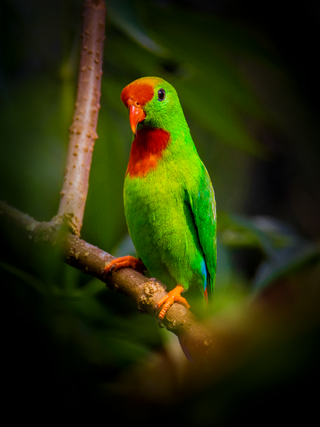
The Sri Lanka hanging parrot is a small parrot which is a resident endemic breeder in Sri Lanka.

Hanging parrots are birds in the genus Loriculus, a group of small parrots from tropical southern Asia.

The blue-and-yellow macaw, also known as the blue-and-gold macaw, is a large Neotropical parrot with a mostly blue dorsum, light yellow/orange venter, and gradient hues of green on top of its head. It is a member of the large group of neotropical parrots known as macaws. It inhabits forest, woodland and savannah of tropical Central and South America, as well as the island of Trinidad in the Caribbean. They are popular in aviculture because of their striking color, ability to talk, ready availability in the marketplace, and close bonding to humans.

The black-billed amazon is a parrot endemic to Jamaica. Sometimes called the black-billed parrot, this amazon parrot is mostly green with small patches of red on the wing and sometimes flecked on the head. Its bill makes it easy to separate from most other amazons, including the yellow-billed amazon, which also lives in Jamaica. It is the smallest Amazona parrot at 25 cm (10 in).

The green-rumped parrotlet, also known as the green-rumped parakeet, is a species of parrot in the family Psittacidae that is found in northeastern South America and the Caribbean island of Trinidad. The green-rumped parrotlet occurs from northern Venezuela eastwards to the lower Amazon in Brazil, Also Suriname and has been introduced to Curaçao, Jamaica and Barbados. It prefers semi-open lowland areas and is also sometimes present in city parks. There are five subspecies.

The colourful princess parrot is an Australian bird of the parrot family. Its name was given in honour of Princess Alexandra of Denmark, who in 1863 married the Prince of Wales Edward VII and eventually became Queen of the United Kingdom. Other names for the species include: Queen Alexandra parrot, Alexandra's parakeet, Princess of Wales parakeet, rose-throated parakeet, and spinifex parrot. Their plumage is mostly green with a pink throat, bluish crown and rump, and bright green shoulders.

The red-capped parrot is a species of broad-tailed parrot native to southwestern Australia. It was described by Heinrich Kuhl in 1820, with no subspecies recognised. It has long been classified in its own genus owing to its distinctive elongated beak, though genetic analysis shows that it lies within the lineage of the Psephotellus parrots and that its closest relative is the mulga parrot. Not easily confused with other parrot species, it has a bright crimson crown, green-yellow cheeks, and a distinctive long bill. The wings, back, and long tail are dark green, and the underparts are purple-blue. The adult female is very similar though sometimes slightly duller than the male; her key distinguishing feature is a white stripe on the wing under-surface. Juveniles are predominantly green.

The Australian king parrot is a species of parrot endemic to eastern Australia ranging from Cooktown in Queensland to Port Campbell in Victoria. Found in humid and heavily forested upland regions of the eastern portion of the continent, including eucalyptus wooded areas in and directly adjacent to subtropical and temperate rainforest. They feed on fruits and seeds gathered from trees or on the ground.

The red-winged parrot is a parrot native to Australia and New Guinea. It is found in grasslands, savannah, farmland, and woodland.

The white-crowned parrot, also known as the white-crowned pionus in aviculture, is a small parrot which is a resident breeding species ranging from eastern Mexico to western Panama.

The northern rosella, formerly known as Brown's rosella or the smutty rosella, is a species of parrot native to northern Australia, ranging from the Gulf of Carpentaria and Arnhem Land to the Kimberley. It was described by Heinrich Kuhl in 1820, and two subspecies are recognised. The species is unusually coloured for a rosella, with a dark head and neck with pale cheeks—predominantly white in the subspecies from the Northern Territory and blue in the Western Australian subspecies hillii. The northern rosella's mantle and scapulars are black with fine yellow scallops, while its back, rump and underparts are pale yellow with fine black scallops. The long tail is blue-green, and the wings are black and blue-violet. The sexes have similar plumage, while females and younger birds are generally duller with occasional spots of red.

The yellow-crowned amazon or yellow-crowned parrot is a species of parrot native to tropical South America, Panama and Trinidad and Tobago in the Caribbean. The taxonomy is highly complex and the yellow-headed and yellow-naped amazon are sometimes considered subspecies of the yellow-crowned amazon. Except in the taxonomic section, the following deals only with the nominate group .They are found in the Amazon basin.

Alisterus is a genus of medium-sized Australasian parrots, comprising the Australian king parrot, the Papuan king parrot and the Moluccan king parrot. The three species are respectively found in eastern Australia, Papua, the Moluccas and other Indonesian islands. Predominantly of red and green plumage, the long-tailed parrots are related to the genera Aprosmictus and Polytelis.

The yellow-billed amazon, also called the yellow-billed parrot or Jamaican amazon, is a species of parrot in the family Psittacidae. It is a predominantly green parrot with a short tail and pink throat and neck. It is endemic to Jamaica, where its natural habitats are subtropical or tropical moist lowland forests, subtropical or tropical mangrove forests, subtropical or tropical moist montane forests, plantations, and rural gardens. It is threatened by habitat loss and illegal trapping of wild birds for the pet trade.

The orange-fronted hanging parrot or Papuan hanging parrot is a small species of parrot in the family Psittaculidae. It is endemic to forest in New Guinea and adjacent smaller islands. It sometimes includes the Bismarck hanging parrot as a subspecies.

The Philippine hanging parrot, also commonly known as the colasisi from its local Tagalog name "kulasisi", is a small psittaculid parrot species endemic to the Philippines. It includes about eleven subspecies, at least one of which might represent a distinct species, although further research is needed. While it is listed as Least Concern in IUCN, some subspecies, such as L. p. chyrsonotus of Cebu and L. p. siquijorensis of Siquijor, may already be extinct. The species is threatened by habitat loss, but a bigger threat is trapping for the illegal wildlife trade; wild-caught birds are often sold as pets in streets and online selling groups.

The Sula hanging parrot is a small species of parrot in the family Psittaculidae. It is endemic to forest and nearby habitats on the Banggai and Sula Islands in Indonesia.

The great hanging parrot, also called Celebes hanging parrot, Sulawesi hanging parrot and maroon-rumped hanging parrot, is a species of parrot in the family Psittaculidae. It is endemic to Sulawesi and nearby smaller islands in Indonesia, where it occurs in forest, secondary growth and tall mangrove.

The Bismarck hanging parrot or green-fronted hanging parrot is a small species of parrot in the family Psittaculidae. It is endemic to forest in the Bismarck Archipelago in Papua New Guinea. It is threatened by habitat loss. It is sometimes considered a subspecies of the orange-fronted hanging parrot.

The sapphire-rumped parrotlet is a species of bird in subfamily Arinae of the family Psittacidae, the African and New World parrots. It is found in Brazil, Colombia, Ecuador, French Guiana, Guyana, Peru, Suriname, and Venezuela.






















